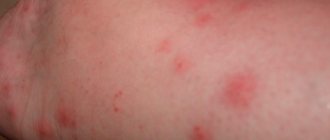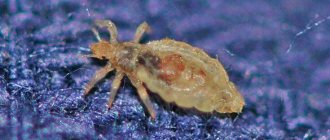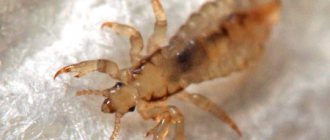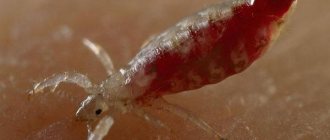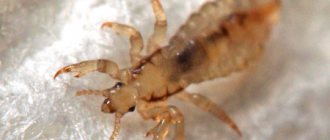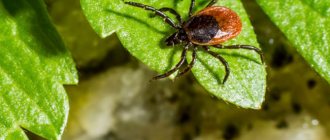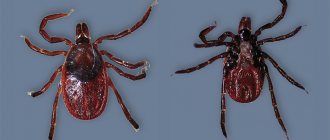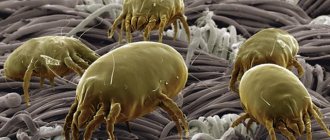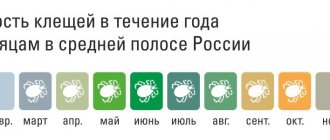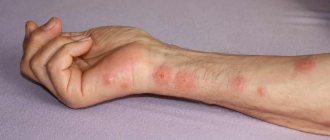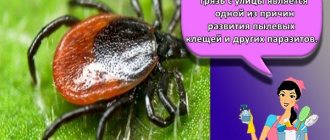There can be many different insects living in your home that cause harm through their vital activity. Among them are linen mites that feed on human blood, leaving an unpleasant mark on the skin. It is possible to fight against linen mites, and now there are a number of effective methods by which these parasites can be easily removed from the house completely.
Next, we will look in detail at the various features of these bloodsuckers, the harm they cause and methods of control. Clothes mites have small dimensions. Their average size is no more than 8 mm, while males are smaller than females. Ticks have a yellow, brown or red tint. It depends on how saturated the tick is with human blood at the moment. It is interesting that these parasites not only have a trunk for easily piercing the skin and sucking blood, but also a special set of jaws, which greatly helps them in feeding.
You can learn more about bed bugs here.
A small tick moves quite freely on a variety of surfaces and quickly hides from humans, even though it has no wings at all. Their low weight and the ability of small notches on their legs to cling to almost anything allows them to move quite freely both on the walls and on the ceiling.
Types of house ticks
House ticks are dangerous parasites that harm household items, products and even human health. They are invisible to the human eye and are found in any living space. More than 160 species of ticks can live in symbiosis with humans. The most popular of them:
- Itchy. It parasitizes only the human epidermis. Develops in a warm, humid environment. Causes a disease - scabies.
- Hairy. Found in foods. Optimal development conditions are an ambient temperature of about +25 degrees. Can cause inflammatory skin lesions in humans.
- Chicken. Distributed in chicken habitats and excrement. It can also parasitize human skin, causing irritation and itching.
- Rat. It lives mainly on the epidermis of rodents, but with a lack of nutrition, it can migrate to humans. Mainly lives in rural areas.
- Dusty. It feeds on dead epidermal cells, fungi, and bacteria. They do not bite, but they do cause damage with their excrement. In small acceptable quantities they do not harm humans, but when the population increases they can cause allergic reactions.
All types of parasitic insects can cause severe diseases of the skin and respiratory tract.
Clothes mites photo
Those people who have never had these insects at home should definitely know about the great harm that linen mites cause to humans. This can push them to quickly and timely destroy these parasites. The harm from linen mites is, in fact, extremely great. In addition to the fact that they feed on human blood in large quantities, they also secrete poisonous saliva into the victim’s body. As a rule, it does not cause any irritation, but sometimes linen mite bites, their symptoms, and consequences are very unpleasant.
This slideshow requires JavaScript.
A slight swelling of the skin at the site of the bite, inflammation, and itching and pain begin. Subsequently, nervousness, lack of sleep, malaise may appear, and the human body significantly reduces its performance. All this, as a rule, is reflected even at the psychological level, gradually worsening the situation.
What does a dust mite look like, its shape and size?
You will not notice the pest with the naked eye, since its size reaches only half a millimeter. They are so small that just 1 gram of house dust can contain from 100 to 2 thousand individuals.
Dust mites can only be studied in detail under a microscope. The insect belongs to the arachnid department and has all the characteristics of individuals of this type. Externally, the parasite looks like a small spider. Its body is covered with a waterproof shell, segmented and flattened. The tick moves on four pairs of legs. Each limb has suction cups, with the help of which the insect is securely held on any surface. In the oral cavity there are 2 pairs of jaws, which are used for grinding food.
More about the parasite
One of the human companions, the linen or bed mite, lives for several hundred years and is distributed in all parts of the world. He feels comfortable with a person. It feeds on dead skin cells, dandruff, lost hair, hides in the folds of dirty bed linen, in pillows, blankets, mattresses and feels great in a dusty room that has not been cleaned for a long time.
Note! A person does not notice the presence of a bed mite if he has good immunity and does not know what an allergic reaction is.
Sensitive people have it more difficult. Their skin and respiratory organs respond to pest bites with endless runny nose, coughing, sneezing, and skin irritations in the form of a small red rash.
It is possible to examine a bed mite (it is a type of saprophyte) only with the help of a microscope, it is so small.
A tick (as we see it in photographs) looks like this:
- yellow-brown;
- the body is flattened, covered with chitin;
- length – from 0.2 to 0.6 mm;
- six limbs with suction cups;
- head in the shape of a triangle.
An adult tick lives for a month and a half, during which time the female lays more than three hundred eggs.
Why do dust mites appear?
From the name it is clear that pests live in areas of massive dust accumulation. They spread in any room where there is dust. If you keep your apartment clean, their population will be negligible and will not harm humans. However, if you do not carry out timely cleaning and do not eliminate possible habitats of parasites, the manifestation of the negative impact of insects on humans is inevitable.
The causes of dust mites can be:
- massive piles of things and trash in the apartment;
- irregular wet cleaning;
- incomplete cleaning of the room (not enough attention is paid to treating corners and surfaces under furniture);
- old bedding, bulky curtains;
- location of the apartment in areas with a lot of dust.
Ticks enter a person's home on outer clothing or on the fur of pets, and also enter the apartment along with dust through windows and doors.
Where do dust mites live?
When parasites enter a living space, they immediately settle in suitable habitats. They feed on dead cells of the epidermis, so they live where dead cells, along with dust, accumulate the most. This may live:
- in pillows with natural feathers;
- in down and cotton blankets;
- in mattresses;
- in carpets with natural pile;
- in bed linen;
- in the upholstery of sofas, armchairs, chairs;
- in soft toys;
- in unused clothing;
- in drapes and curtains;
- on dusty bookshelves;
- in a vacuum cleaner in a dust bag.
It has been proven that in a home where there is a lot of trash, the number of individuals in the population reaches 2 million.
How to understand that a dust mite has appeared in the apartment
Since dust mites are tiny, you won't be able to notice their presence with the naked eye. The first and main sign of a parasite appearing indoors will be how you feel.
A change in your health indicates a dust mite allergy. To diagnose it, consult an allergist. The specialist will prescribe special tests to identify the parasite.
As soon as you are sure that there is a population of dust mites in the apartment, immediately begin fighting the pest.
Which pillows do not harbor dust mites?
It is worth noting that dust mites only appear in feather pillows. If the bedding is stuffed with high-quality artificial material, and it, in turn, is replaced with a new one every 3-5 years, the parasite will not live in such a pillow.
Signs of bed mites in your home
Tick excrement contains a protein that can cause allergies. As soon as symptoms of an allergic disease appear, you need to get tested and consult a doctor.
Read more ► Dust mites: how to get rid of them at home, why they are dangerous, elimination in 4 steps
The main symptoms of allergies include:
- Rash all over the body.
- Unbearable itching.
- Swelling of the eyelids.
- Frequent nasal congestion.
- Loss of appetite.
- Unreasonable frequent attacks of coughing and sneezing.
Dust mite damage
Dust mites have a harmful effect on humans, causing skin reactions and allergic symptoms throughout the body as a whole.
Do dust mites bite?
First of all, it is worth noting that dust mites do not bite humans. Allergic skin reactions in the form of rashes, redness or eczema are usually confused with parasite bites.
Insect waste poses a health hazard. These are feces, chitinous membranes, secretory secretions. They contain protein compounds - enzymes, which, in turn, destroy the skin on which the parasites feed. At the same time, these components cause various complications when they come into contact with human skin.
Who is at risk
The most susceptible to the effects of dust mites are the elderly, children, and allergy and asthma sufferers. Always pay attention to how they are feeling and visit a doctor at the first symptoms.
Symptoms of dust mite allergy
Signs of a dust mite allergy actively appear at night. An allergy develops if you have:
- nasal congestion and runny nose;
- sneezing and itching in the nasopharynx;
- severe runny nose;
- lacrimation;
- dry cough;
- difficulty breathing during sleep;
- skin reactions (redness, itching, rash or eczema).
If you have a stuffy nose at night, a cough and difficulty breathing, and the symptoms go away during the day, this is a reason to see a doctor. Most likely, you are allergic to the parasite.
Don't forget to monitor your pets' reactions. Animals can exhibit the same signs of allergies as humans. If you notice the first symptoms in your pet, contact your veterinarian immediately.
Possible allergic reactions
Dust mites are the causative agents of severe allergic reactions. Their excrement actively affects the mucous membranes of the body and causes:
- Quincke's edema;
- conjunctivitis and rhinoconjunctivitis;
- allergic dermatitis;
- respiratory allergy;
- rhinitis;
- bronchial asthma.
These reactions can even lead to death.
How to treat dust mite bites
Since dust mites do not bite, there is no treatment for bites. Rash and skin irritation are a sign of an allergic reaction. She is treated with special medications prescribed by an allergist. In addition, the first necessary help when skin reactions occur is wet cleaning and clearing the apartment of unnecessary trash.
How to treat a child's dust mite allergy
Just as when allergies occur in adults, the first aid against skin and other reactions in a child will be a visit to an allergist, as well as limiting contact with the allergen. To do this, general cleaning is carried out, bedding is washed, and unnecessary trash is thrown away.
Do not self-medicate under any circumstances. To relieve allergic reactions in children, medications prescribed by a doctor are used. These include antihistamines, nasal agents and corticosteroids, for example: Suprastin, Telfast, Aleron, Erius. Please note that medications only stop the manifestation of allergies, but do not eliminate the cause of its occurrence.
Prevention measures
If you follow a number of recommendations, you can prevent the appearance of bed mites in a person’s home. For example:
- When buying new and especially used furniture or appliances, you need to carefully check them for the presence of parasites.
- It is advisable to check the home for all types of cracks and then close them.
- In places where these pests may appear, it is better to place small bunches of tansy, wormwood, lavender or other plants whose smell these pests cannot stand.
- When traveling, do not stay in cheap hotels that have poor insect control.
Bed tick bites are not a problem if the bite sites are treated promptly. To avoid this problem, you need to take a number of measures and follow certain rules so that you don’t have to think about how to treat bite sites.
Ways to get rid of dust mites at home
Unfortunately, it is impossible to completely get rid of dust mites. However, it is possible to reduce the number of individuals in the population to the maximum permissible norm. To destroy the pest, you can use both improvised methods and means, and special objects.
Reducing indoor temperature and humidity
You can get rid of dust mites by changing their favorable habitat conditions. Since the parasite is active at an air temperature of 22-26 degrees and relatively high humidity, a decrease in these indicators will lead to the death of a larger number of individuals.
Ventilate the room as often as possible, lower the temperature and humidity. Optimal indicators for stopping the vital activity of ticks, and at the same time normal human existence:
- temperature from +18 to +21 degrees;
- humidity level is not higher than 40%.
If you are unable to reduce the humidity level in the room, buy a special device that dehumidifies the air.
Wet cleaning
Be sure to carry out general cleaning from time to time and wet cleaning daily. Get rid of old furnishings, things that accumulate dust, worn-out mattresses and bedding. Also remove curtains, curtains, soft toys, artificial flowers. Treat horizontal surfaces and floors with water with dissolved salt (3 tablespoons per 10 l) and a few drops of essential oil.
Treating bedding with high temperatures
Change bed linen at least once every 2 weeks, and at the first manifestations of allergies - once every 7 days. Wash textiles and linen in hot water, dry naturally and iron with an iron with a steam function. You can treat furniture and large bedding using a steam generator or hot water. If you add 2-3 drops of essential oil to the steam generator liquid, the treatment effect will increase several times.
If you have been using pillows, blankets or mattresses for a long time, replace them with new ones. In this case, it is better to replace feather pillows with silicone ones, and old mattresses with orthopedic ones.
Effect of ultraviolet
Ultraviolet radiation not only kills ticks in just 2 hours of exposure, but also destroys protein bonds in enzymes contained in their metabolic products. As a result, they lose their allergenic properties. If possible, take bedding, carpets, and toys out to bask in the sun for 2–3 hours. You can also treat the affected areas in the apartment with ultraviolet light using a special lamp.
Freezing
Dust mites cannot withstand low temperatures and die in just 2 hours at -5 degrees. If you have toys or bedding that can't be washed in hot water, such as silk or wool, simply freeze them. If the item is small, pack it in a bag and put it in the freezer for 3-5 hours. After freezing, shake the product thoroughly to remove as many dead specimens as possible.
For large items, such as carpets, airing outside in frosty weather is suitable. Just take the carpet outside and thoroughly “bathe” it in the snow. In this way, you can not only destroy pests, but also clean the carpet from dust and dirt.
Mattress cover against dust mites
You can prevent the proliferation and spread of dust mites in your bed with the help of a special mattress cover. It is made of hypoallergenic cotton, which prevents parasites from developing in bed and also reduces the possibility of skin reactions. You can buy an anti-mite mattress cover in a specialized store or order it online. The average cost of such a product is 1800 ₽.
Pillowcase against dust mites
A product similar to a mattress cover is a pillowcase against dust mites. Made from hypoallergenic polyester, which does not allow dust and allergens to pass through. Pillowcases come in a wide variety of shapes and sizes. You can buy such a device for about 1300 ₽.
Using infusor soil
Ciliate earth or kieselguhr is made from the skeletons of single-celled aquatic organisms. The fine powder consists of tiny fossilized remains that are as sharp as a blade. They do not harm humans, however, they have a detrimental effect on small pests.
When choosing, make sure that the kieselguhr is intended for food purposes. Sprinkle the powder generously onto bedding, mattresses, pillows and blankets and leave overnight. Then remove any remaining substance from the furniture with a vacuum cleaner and wash the bed linen.
The influence of indoor plants
Houseplants both promote and slow down the development of mites. If you don't take care of your flowers and rarely dust the leaves, populations of dust mites can settle on their surfaces. At the same time, certain plants, when properly cared for, not only do not collect ticks on the surface, but also purify the air. These include:
- gerbera;
- geranium;
- chlorophytum;
- philodendron;
- dipsis yellowish;
- spathiphyllum;
- ficus;
- dracaena.
You can also place fresh bouquets of mint, lemon balm, lavender or chamomile around the apartment. Their smell repels parasitic insects.
Tea tree oil
At the first symptoms of an allergy, tea tree oil will help you feel better. Its effect significantly reduces the tick population.
Dilute 1 teaspoon of essential oil in a glass of distilled water and pour into a container with a spray bottle. Treat all surfaces that accumulate dust with the substance, and you will immediately feel better. Use this spray regularly.
Ammonia
Use ammonia products with extreme caution. It is better to avoid using ammonia if children or pregnant women live in the house.
Prepare a homemade insecticide based on ammonia. To do this, mix ammonia with distilled water in equal proportions and add 2-4 drops of any essential oil to the solution. Pour the liquid into a container with a spray bottle and treat all objects that accumulate dust. Be extremely careful not to use treated items until the alcohol vapor has completely evaporated.
Which vacuum cleaners are better for dust mites?
Unfortunately, conventional vacuum cleaners only raise dust and do not eliminate the problem. However, it is extremely difficult to clean your apartment without a vacuum cleaner. Having a washing vacuum cleaner will be a definite plus in this matter.
In the last few years, special vacuum cleaners for exterminating dust pests have appeared on the household appliance market. The device helps reduce the population of individuals due to the built-in ultraviolet lamp and a special dust collector that does not allow even the smallest particles to pass through. The cost of such a vacuum cleaner varies between 13,000 rubles.
Of course, not everyone can buy such equipment. For a standard household vacuum cleaner to help, follow these recommendations:
- choose a model with a hepa filter, which reduces the emission of sucked dust;
- vacuum not only the floor, but also drapes, curtains and furniture;
- vacuum at least 3 times a week;
- After dry treatment, carry out wet cleaning.
Open the windows
Ventilate the room as often as possible and turn on the air conditioner. The flow of fresh air can reduce the amount of dust by 30%.
Use rugs and slippers
Lay a grate mat in front of the entrance to the apartment. This will help reduce dust entering the living space by 40%. Don’t forget to clean your door mat and slippers from dust in a timely manner.
Air filter or cleaner
An excellent solution would be to use a special air purifier. Such a device can destroy almost all possible household allergens. To make the purifier work as efficiently as possible, close all windows and doors while it is running, and also clean the filters on time.
Minimize space
Remove unnecessary items and supplies from your closet. Do not clutter the walls and shelves in the apartment with soft toys, books, or massive paintings. Sort through and throw away unnecessary junk. By removing objects that can accumulate dust, you will significantly reduce the spread of dust mites.
Steam generator
With the help of a steam generator you can get rid of mites in furniture, carpets, and curtains. To completely destroy the population, several treatments per day are sufficient, taking no more than 5 minutes. Simply fill the reservoir with water and turn on the device. The water is heated and steam is converted, leaving the device under pressure. Carefully treat all surfaces and repeat the procedure if necessary.
Ozone generator
Unfortunately, it is not mentioned anywhere that ozone can destroy ticks, so using an ozone generator in an apartment is not rational. In addition, there is an opinion that gas slows down a person’s metabolic rate and disrupts his biorhythms.
Effective methods for treating bites
Many people's bodies respond adequately to bed tick bites, and they heal on their own within a few days. There are people who need emergency help because their body reacts in a very specific way. For atypical reactions it is necessary:
- Wash the bite areas thoroughly with soap or soda solution, then rinse them with clean running water. To prepare the solution, take a glass of water and add a spoonful of soda or liquid soap.
- Bite areas must be disinfected with any alcohol-containing product, such as vodka or moonshine, cologne or perfume.
- Severe itching indicates an allergic reaction. To reduce these symptoms, you can use both pharmaceuticals and folk remedies.
Folk remedies
There are a number of effective and proven recipes. For example:
- Bite areas should be wiped with pure vinegar. There is no need to rinse the product.
- You can apply a piece of ice or some product from the freezer to the bite site.
- Applying a used black or green tea bag to the bite site will relieve the victim of discomfort.
- Lotions are also made from medicinal herbs. St. John's wort is considered the most effective remedy. To prepare the solution, you need to take a spoonful of St. John's wort and pour a glass of boiling water. After the infusion has cooled, soak a cotton swab in the infusion and apply it to the wound for half an hour. Herbs such as chamomile or calendula are suitable. The product is prepared in the same way as St. John's wort base.
- Treatment with a composition based on aloe and plantain. After mixing the ingredients, the wound is treated several times a day. The juices from these plants help reduce swelling of the bite site, reduce itching and have an antibacterial effect.
- Onion and garlic juices in combination act in a similar way on the bite site. The smell of onions and garlic, in addition to relieving discomfort, also helps repel these leeches.
- You should drink at least 5 tablets of activated charcoal to flush out toxins from your body as quickly as possible.
As a rule, folk remedies help a person cope with negative consequences in the initial stages. If these remedies do not cope with the task, then pharmacies should be used. Alternatively, you can use essential oils, which have the same effect as herbal infusions.
Essential oils of such plants are recommended to be used as:
- Lemon.
- Orange.
- Lavender.
- Geranium.
- Tea tree.
- Needles.
- Juniper.
- Cypress.
- Sage.
- Mint.
Medications
There are both special remedies developed for the bites of various insects, and non-special ones that cope with this task. The fact is that each body reacts differently to bed tick bites.
Typically the following pharmaceuticals are used:
- Special ointments “Fenistil” and “Rescuer”. These remedies have a wide spectrum of action and help protect the victim from negative consequences.
- Vietnamese star, which is characterized by an antibacterial effect.
- Afloderm helps cope with severe itching.
- Propolis tincture is effective against any bites.
- Afloderm ointment is used with Tavegil, which helps relieve the symptoms of allergic reactions.
- The chatterbox “Tsindol” will easily cope with the task.
- Akriderm perfectly relieves signs of inflammatory processes.
Remedies for dust mites
In addition to available means to combat dust mites, you can use special aerosols and shampoos designed to destroy the parasite and purify the air.
Benzyl benzoate
The substance is intended for treating human skin. Apply the product to exposed skin and the ticks won't even get close to it. With similar actions, you can alleviate allergic reactions that occur upon contact with waste products of the pest. The action of Benzyl benzoate lasts for 36 hours, after which it must be washed off with water.
Staloral
A product aimed at reducing allergic reactions from dust mites. Intended for oral administration under the tongue. Contains a small dose of allergen to enhance immunity. During the use of Staloral, a person's sensitivity to the pathogen decreases and disappears over time, being replaced by a normal reaction.
Easy air spray
An acaricidal drug designed to clean the air from parasites and other allergens. Presented in the form of a spray in a 1 liter bottle. The Polish manufacturer assures that after using the product, protection against dust mites lasts for at least 2 weeks. It is recommended to use Easy air immediately after wet treatment.
Spray Alergoff
The aerosol is designed to combat all kinds of allergens in the apartment. Treat bedding, upholstered furniture and carpets with the substance, and dust mites will not appear within six months.
Milbiol spray against dust mites
The product is produced in Switzerland. Presented in 250 ml bottles. If you spray the substance on all carpets, upholstery, pillows and other objects that accumulate dust, Milbiol will last for 2-3 weeks.
Fleas
Fleas are small insects measuring 1-4 mm in size. The body has a flattened shape, making the insect difficult to catch. They are distinguished by great jumping ability due to the presence of long hind legs and high “maneuverability” - the flea easily runs from place to place in the animal’s thick fur
The natural hosts of fleas are warm-blooded animals with fur. A person, as an organism for constant life activity, is of no interest to a flea. Fleas that can live on a person for some time and bite him are called Pulex irritans, cat fleas, Ctenocephalus telis, can also feed on human blood. They can get into a person’s home with animals, as well as on the person himself, attached to his clothing.
Harm to humans
In addition to pain at the time of the bite and constant itching after the bite, flea bites can result in serious diseases carried by these insects: plague, dermatophiliasis, pulicosis, rat typhus, rickettsiosis, tularemia, listeriosis, dipylidiosis.
Secondary infections that occur as a result of scratching wounds result in furunculosis, abscesses, ulcers and ulcers. An allergic reaction to a flea bite leads to extensive skin irritation, which can ultimately result in neurosis and insomnia.
Flea bites on a person
Most often, fleas bite on the lower extremities. When living in blankets and upholstered furniture, fleas can bite other parts of the body. When biting, the flea firmly attaches itself to the human skin and may look like a black dot.
The symptoms of a flea bite are vivid and difficult to confuse with other types of bites. By biting, the insect injects a special enzyme into the wound that thins the blood. The bite itself is accompanied by sharp pain, which turns into itching and burning. At the site of the bite, a hyperemic spot with a diameter of about 5 mm remains, in the center of which there is a bloody dot.
The spot swells, the hemorrhagic point remains visible for 3-5 days and causes significant itching. When an allergic reaction develops, urticaria occurs.
Children may also experience general symptoms, especially with multiple bites: low-grade fever, anxiety, diarrhea.
What to do if you are bitten by fleas
- Treat the bite site with an antiseptic - hydrogen peroxide, alcohol solution, potassium permanganate.
- Apply a cold compress to the bite site.
- Apply antipruritic or antiallergic ointment to the bite area.
- During the entire period of resolution of the bite on the skin, it is important not to scratch the wound, as this will lengthen the recovery period of the skin and threaten secondary infection. Soda lotions (1 teaspoon of soda per glass of water) will help relieve itching.
- If the wound does fester, you should apply a sterile cotton swab with an antibiotic-containing ointment (levomekol, gentamicin, etc.) to the abscess.
How to get rid of fleas
- Remove fleas from pets using special insecticides.
- Disinfect animal habitats - bedding, soft houses. To do this, they need to be soaked in a solution of household disinfectant, then washed in water at a temperature of about 50 C and rinsed thoroughly.
- Treat the apartment and car interior with a special insecticide, carefully following the instructions and safety rules - Tetrix, Effective Ulra, Solfak, Chlorpirimark. If necessary, treatment is repeated after 2-3 weeks.
- If you are intolerant to chemicals, you can use the herb wormwood, which should be spread around the apartment, especially on the floor and at the entrance.
- Throw away the dust bag for the vacuum cleaner, where fleas happily live and breed.
Preventive measures
Of course, it is easier to prevent a problem than to fight it. To reduce the risk of a massive appearance of dust mites, clean your apartment regularly, wipe horizontal surfaces and floors with a damp cloth, wash bedding and accessories on time, clean carpets and upholstery.
Additional tips:
- Change pillows and blankets every 5 years. Give preference to synthetic rather than natural fillers.
- Buy a hypoallergenic mattress. Ventilate it regularly in the sun or frost, clean it with a steam generator, or take it to the dry cleaner once every 12 months.
- Don't sleep on a bed without bedding.
- Store books in locked cabinets.
- Ventilate your apartment daily.
- Use air purifiers.
- For cleaning, use washing vacuum cleaners or devices with hepa filters.
- Do not forget to regularly wash curtains, curtains, toys, covers on chairs and sofas.
- From time to time, inspect your apartment and throw away unnecessary trash.
- Groom your pets regularly, bathe and brush their hair.
Following these rules will help prevent the appearance of dust mites and reduce the risk of allergic reactions.
Dust mites are a dangerous pest. It does not parasitize human skin, but it secretes dangerous enzymes that contribute to allergic reactions in adults and children. The main enemy of the parasite is cleanliness. With regular wet cleaning, you will not only get rid of the problem, but also prevent its occurrence, thereby reducing the risk of life-threatening allergic reactions.
Measures to combat bullet mites
To prevent this from happening, you need to get rid of parasites. Complete extermination will not be easy to achieve: animals reproduce quickly and are resistant to environmental factors. But it is necessary to organize certain measures aimed at combating them:
- Carry out frequent wet cleaning with a vacuum cleaner with an aqua filter or a multifunctional cleaning system. You will deprive insects of their food supply.
- If possible, replace upholstered furniture with leather upholstery.
- Remove carpets, including synthetic ones. Or just take them out into the cold from time to time. Do the same with soft toys. Store them in closed boxes.
- Wipe off dust on books with a damp cloth.
- Store bedding in covers. Boil them and dry them in frosty weather in winter.
- Leave the mattress outside at sub-zero temperatures for 5-6 hours, the frost will destroy the ticks.
- Clean pillows using special equipment. Its loading hopper is equipped with an ultraviolet lamp. Its bactericidal properties have a detrimental effect on microscopic organisms.
- Use acaricides, textile treatments by spraying or washing.
Ticks are easy to eliminate if you know at what temperature they die. These organisms do not tolerate frost and ultraviolet radiation. At - 5º C, ticks die within 2 hours, at + 40º C - within 6 hours. The main condition when fighting them is clean and dry air. The less dust there is in the house and the cleaner it is, the worse it is for arthropods.
How to properly remove a tick - first aid for a tick bite
If it is possible to get to a medical facility as soon as possible, this should be done; doctors will quickly and without consequences remove the tick. If this is not possible, you should remove the tick yourself as quickly as possible:
Put rubber gloves on your hands and a plastic bag. Remove the tick:
- using special devices (Tick Twister, Ticked-Off, The Tickkey, Trix Tick Lasso, Anti-tick). They are always accompanied by detailed instructions for use.
- using thread. A strong thread is draped over the tick's head at the very base, i.e. near the skin in the form of a loop. The ends of the thread are carefully tightened, after which, holding the ends of the thread, you should rotate the tick clockwise or counterclockwise - a couple of movements, and the tick can be easily removed from the wound.
- using tweezers. Using the tip of tweezers, carefully grasp the head of the tick and twist it without pressing on the abdomen or tugging.
After removing the tick, place it in a glass jar.
- Remove tick remains with a sterile needle if they remain in the wound. It is best to use a sterile needle from a new syringe; in extreme cases, you can take a regular needle, hold it over the flame, treat it with alcohol a minute after it has cooled, and only then remove the tick.
- Treat the wound with an antiseptic.
- Send the extracted tick to the laboratory for testing.
How does a tick bite occur?
It is almost impossible to detect a tick bite immediately. Tick bites are lubricated with a special anesthetic substance, so it is practically not noticeable. Particularly sensitive people may feel discomfort in the form of a nagging pain, a feeling as if a speck or butcher's broom had gotten under their clothes.
The tick tries to choose areas with delicate and thin skin, which is easier to bite through:
- neck;
- behind the ear area;
- armpits;
- code under the chest;
- groin and genitals;
- buttocks.
At the moment of the bite, the tick bites through the skin and places a hypostome, a special outgrowth of the pharynx with teeth that hold the tick, into the wound. In the process of sucking blood, the tick increases significantly in size.
If a tick is infected with tick-borne encephalitis, it retains the causative virus throughout its life. The virus enters the human blood through the saliva of the biting arthropod, so a person becomes infected in the first minutes after a tick bite; early removal of the parasite does not exclude infection with a dangerous infection. The same applies to tick-borne fevers.
If a tick is infected with borreliosis, the pathogenic bacteria enter the human blood only when the tick begins to suck blood, because live in the gastrointestinal tract of arthropods, and this is a few hours after the bite. In this case, early tick removal can prevent disease.
Consequences of an encephalitis tick bite - symptoms of tick-borne encephalitis
The latent period is 5-25 days, but most often symptoms appear in the period 7-14 days after the tick bite. The general symptoms characteristic of this infection begin acutely and vividly, i.e. The patient can clearly indicate the start time of the clinic:
- heat;
- chills;
- Pain in the eyes;
- photophobia;
- pain in muscles, bones and joints;
- headache;
- vomit;
- lethargy and drowsiness;
- seizures (in children);
- redness of the sclera of the eyes, skin of the face, neck, upper body.
Forms of encephalitis
The target organ of the disease is the brain (see statistics on tick-borne encephalitis). There are several forms of encephalitis, which have their own clinical characteristics.
- Feverish form
Diagnosed in 40-50% of cases. Fever, the main symptom of the disease, lasts 5-6 days at a level of 38-40 C. After the temperature drops, the main symptoms disappear, but weakness and lethargy remain for several more weeks. Complications occur very rarely.
- Meningeal form
This is 50-60% of cases. It occurs with severe general intoxication (hyperthermia over 38 C, fever, chills, sweating, high-intensity headache), as well as symptoms of inflammation of the meninges: nausea and vomiting, decreased elasticity of the occipital and neck muscles (difficulty when trying to bring the chin to the neck), facial asymmetry, dilated pupils. Recovery is long, remission occurs in a state of weakness and weakness. Chronitization of the process is possible.
- Focal form
The heaviest downstream. Characteristics: high temperature, impaired consciousness with delusions and hallucinations, severe intoxication, convulsions, disorientation in space, impaired breathing and heart function. Most often it becomes chronic.
- Chronic form
Develops over several months and even years after the disease. Frequency - 1-3% of cases of the total number of cases. The patient experiences constant twitching of the muscles of the neck, shoulder girdle and face, tendon reflexes and muscle tone in the limbs decrease, the psyche is disturbed, and dementia develops.
A PEST THAT IS NOT SEEN
A dust mite (in other words – bed mite, linen mite, sofa mite, “farina”, pyroglyphide) is a microscopic arachnid insect. The average size is 0.2-0.3 mm. A specimen can only be seen well through a microscope.
An adult tick has 4 pairs of legs, a flattened body and no wings. The sensory apparatus allows you to navigate well in space even without eyes. The common name “dust mite” refers to about 150 species. Parasites live in colonies; in 1 g of dust their number varies from 10 to 30 thousand. The lifespan of an individual is up to four months. During this time, the female can lay about 350 eggs. In the apartment, dust mites live along the entire perimeter, concentrating on upholstered furniture, bedding, clothes, soft toys, bookshelves, and in dusty corners. When highly contaminated, they can be found in hair and skin. Remains of the epidermis, dandruff and hairs (their scales) serve as a source of food for them.
A person regularly supplies parasites with food, daily losing 1-2 g of the dead stratum corneum of the skin (that is why they are called synanthropic, coexisting with people). They are unpretentious to living conditions, but love high humidity and warmth. The comfort temperature range is 20-30 degrees. In an unheated room, the tick will overwinter and give birth to offspring as soon as it warms up. The parasite can be easily brought into the house. Most often it is carried with clothes in the spring and summer. The neighborhood can go unnoticed for a long time, because the tick does not bite and does not manifest itself until a certain time.
